
Some of the various religious denominations, presently: in this county, are
Congregationalist, Episcopalians, Quakers, Presbyterians, Calvinistic Baptists,
Freewill Baptists, Methodists, Universalists and Shakers.
According to
the men of the Massachusetts Colony, all of our ancestors were nothing more than
godless, lawless persons. Town records and histories seem to contradict that
statement and instead indicate that all proprietors interested in the early
settlements were of the "Established Church" and it was only natural that those
whose came out with them would be also. Names appearing on the early colonial
records: Gorges and Mason, Godfrie and Neal, Gibbons and Chadbourne and
Williams, were no doubt of this faith.
Barrington--Rev. Theodore Wells (probably written by him)
The
Town of Barrington formerly included what is now Barrington and
Strafford. It was owned by proprietors in Portsmouth. The town was
incorporated in 1722. One condition of the charter was that a house of
worship should be erected within seven years, that two hundred acres of
land be appropriated for a parsonage, and two hundred acres for the
first minister. The house was raised near the center of Barrington, and
was subsequently removed to within about two miles of the lower line of
the town.
Several appropriations were made by the proprietors of
the town towards completing the house of worship. The Congregational
Church was organized by a council of ten regular churches, June 18,
1755, consisted of seven male members. At the same time Rev. Joseph
Prince was ordained pastor. He was dismissed in 1768. He was blind. He
was noted for his religious fervor. Twelve or fourteen years after
leaving Barrington, he was settled in Candia.
Rev. David Tenney
was ordained over the church in Barrington Sept. 18, 1771, and was
dismissed, at his own request on account of ill health, Oct. 26, 1778.
Having taken his final leave of Barrington, as he was proceeding to his
friends in Massachusetts, he was suddenly attacked with illness at
Durham and died immediately. The people were supplied with preaching a
part of the time during the year, for several succeeding years, by
different individuals.
August 25, 1784, Rev. Benjamin Balch who
had been previously settled in Dedham, Ms., was installed pastor here.
Efforts appear to have been made to maintain strict discipline in the
church in the early part of Mr. Balch's ministry. His connection with
the church and society continued till his death, which occurred May 4th,
1815 at the age of 74 years.
He supplied the desk till about the
time of his decease, though his mind had become so broken, and his
health so infirm, that the parish seems to have assumed the oversight of
his affairs for several years. Finally, deeming it inexpedient that he
and his family should continue at the parsonage, the parish voted to
engage some suitable person to take the best possible care of Mr. Balch
and his family for one year. An arrangement to this effect was made with
his son-in-law who resided in town. After taking his last leave of the
old parsonage, he set out on foot, (preferring to walk) for the
residence of his daughter, about two miles distant. He had nearly
reached there, when he was seen to walk unsteadily and to sit down by
the roadside. He died on the spot.
The church now continued
without a pastor thirteen years. A strong leaven of Unitarianism was
developed in the society soon after Mr. Balch's death, and it seemed
doubtful, for a time, what influence would preponderate.
The desk
was supplied with Unitarian preachers a part of the time, one or two of
whom were employed as candidates for settlement. The scale was finally
turned by one or two of the Unitarians, who preferred to have an
Orthodox society and an Orthodox minister rather than division.
Rev. Cephas Kent was ordained over the church and society Oct. 22, 1828.
He was a native of Benson, VT, and a graduate of the Middlebury in 1824.
While Mr. Kent was pastor the church took pretty decided action in the
Temperance reform. He preached the word faithfully. He was dismissed May
3, 1830.
Rev. Samuel H. Merrill was ordained Feb. 23, 1831.
During the few years of Mr. Merrill's ministry, there was considerable
religious interest and fifty-two persons were admitted to the church on
profession of faith. He was dismissed at his own request Aug. 18, 1835.
The people were now supplied a year and a half by the venerable Father
Ward.
Rev. Samuel Nichols was installed Sept. 20, 1837. A council
was called on the 26th of Oct. 1842, to dismiss Mr. Nichols at the
request of the church and society, on account of an alleged inability to
meet the current expenses, and pay off a debt which had been
accumulating for several years. It was with reluctance decided that the
dissolution should take place unless an arrangement could be made before
the first of December. Mr. Nichols died a little more than a year after
his dismission, at South Reading, MA.
The present pastor, Rev.
Theodore Wells, commenced preaching here in July 1843, and was ordained
June 11th, 1845. The Congregational parish in Barrington was
incorporated by the State Legislature, in 1818. It has a fund of about
$2,300, principally in bank stock, a parsonage, and twenty-five acres of
land. The fund was obtained in the following way: About 1790, a town
collector becoming a defaulter, the town came into possession of his
far. A larger part of the claims were relinquished to the parish. The
rights of the remaining part were purchased by the parish, and by the
liberality of individuals. This farm was sold and the money invested as
a permanent fund. A new and commodious hours of worship was erected in
1840, at a cost of about $2,400--having forty-six pews on the floor. It
has since been furnished with a bell. The congregation varies in
pleasant weather from 100 to 150. The church numbers 45. The salary of
the pastor is $450.
Transcribed and contributed by Karen Heath Penman, Ogden, UT
In 1838 the Baptist Church in North
Conway was built, and financed by the pew holders. This was the first
church built right in the village of North Conway. One of the things
about this church is that the bell in its steeple was made by Paul
Revere.
Mr. Luther Whitaker, Mr. James C. Willey and Mr. Jonathan
Thompson built the church of their own means and sold the pews to pay
for it, in a public auction. Following are the names of the first pew
holders:
Charles S. Whitaker
Luther Whitaker
James C. Wiley
Amos Eastman
Tufton Seavy
William Mason
Samuel C. Randel
Stephen Willey
Joseph Pendexter
Simon Seavey III
Fox Densmore
John M. Bains
Daniel T. Langlay
Gideon Randel
Samuel Willey
Nathaniel R. Mason
Jonathan Thompson
James Wiley
John H. Gile
Elijah F. Densmore
Joseph Bean
Jedediah Lovejoy
Nathaniel Gile
Thomas Quint
William Hart
Andrew Densmore
John Densmore
Enoch F. Chandler
Eamuel W. Thompson
Melvin W. Thompson
Melvin
Seavey
Jeremiah Thompson
Contributed by Ellen McGrath, extracted from Conway Through the Years and Whither, by Ruth Horne, page 24
In
East Moultonborough – the town’s first meeting house was built in 1773
near today’s Shaw Cemetery. It became a Congregational Church.
Although Rev. Samuel Perley was the preacher for a short time, Rev.
Jeremiah Shaw who came in September, 1779, has been honored as its early
pastor. Rev. Jeremiah Shaw was born in Hampton, N.H., in 1747, was
graduated from Harvard College, and was ordained on November 17,1779,
soon after coming to Moultonborough.
The church building blew
down in a severe storm in December, 1819, but was replaced before Rev.
Jeremiah Shaw retired about 1825. Rev. Josiah Dodge succeeded him.
At Moultonborough Corner another group of worshippers, also
Congregationalists, used the Town House built in 1834. This was not
surprising since the town funds supported the early ministers. Then
Sunday services alternated between Moultonborough Corner and East
Moultonborough.
Itinerant Methodist preachers traveled in New
Hampshire and came to Moultonborough where, by 1839 the Methodist were
holding regular meetings. Rev. J.S. Loveland became their pastor in 1840
In 1843, under the leadership of Rev. H. Hartwell, a church was
built at the junction of Route 25 and Old Route 109.
In 1850, the
Congregationalists who had been using the Town House decided to build a
meetinghouse of their own just west of it, at a cost of about one
thousand dollars. The construction details of this building are
described in Frances Stevens book, "As I Remember Moultonborough, New
Hampshire. pp. 161-162."
Three churches were in town until about
1866 when a separation of Church and State stopped town funds from
helping to support them. The two Congregational churches were no longer
able to continue. The church building in East Moultonborough was sold to
Adventists in Melvin Village and moved there across the ice of Lake
Winnipesaukee. The church building at Moultonborough Corner was to be
auctioned off on May 6, 1869.
At the New England Annual
Conference in Lisbon on April 7, 1869, permission was given to the Board
of Trustees of the Moultonborough Methodist Episcopal Church to sell its
present property and reinvest in the larger building up for sale.
The Trustees decided to bid at the auction not more than six hundred
dollars. Fortunately, they got the property for only three hundred and
twenty-five dollars
Then the former meeting place was sold to Mr.
H.S. Ward for three hundred dollars. The family of Dr. Junkins lived
there, then the family of Dr. Frank S. Lovering and eventually it became
an inn and restaurant.
The newly purchased building to
become the Methodist Episcopal Church was moved to the center of the
village and placed over a cellar of the Alvin Peavey house (which had
burned about 1860) where it stands today.
Mrs. Eliza True, an
active church member, deeded her home to the church to be used as a
Parsonage. This property almost directly across the street from the
church, came to it after her death September 12, 1880.
The early
Methodist church had its own library of 170 volumes in 1859 and 150
volumes in 1871.
Reports show that in 1870 the Sabbath School had
57 scholars and teachers with an average attendance of 43. In 1880 it
was about the same: 63 with average attendance of 48.
In 1905 and
1906 under the leadership of Rev. Dick Ezra Burns, the church building
was repaired and eight memorial stained glass windows replaced the plain
ones.
They are: "True" in memory of Eliza True
"French" in
memory of James French former owner of the Old Country Store and
postmaster.
"Bryant" and (4) "Berry" are two windows in memory of
John Bryant and John Berry who built the church.
"Augustus and
Harriette Jaclard" are great-grandparents of Adele Taylor, owners of the
large house, which stood where the library was.
"N.M. Lee and
Lyman Brown" Nathan Lee was the father of David Lee who built Lee’s
Mills. Lyman Brown held many town offices, was a justice of the peace,
and county commissioner.
"Alma F. Spencer-Rollins" This family
lived on Holland Street. Their Cape Cod house was enlarged and is became
the Holland House.
"Knights of Pythias" This window was given by
the Lodge which was active in Moultonborough for many years.
On
July 16, 1923, at the Quarterly Conference of the Moultonborough
Episcopal Methodist Church were Rev. Harvey Sawyer, District Supt. Rev.
E.A. Durham, and members: Azilla Berry, Flossie Berry, Clara Smith,
Susie Smith, Ralph Goodwin, and George Blanchard.
The Pastor’s
salary was set at $650 and he was granted a two-week vacation.
The Congregational Church built a new meetinghouse in 1856 just below the brick store. Isaac Adams and Joseph Wentworth donated money and land for the parsonage. But there was a lot of difficulty getting a minister who pleased the congregation. With the proximity of other churches in the area it drained the congregation, and the last regular service was held in 1880.
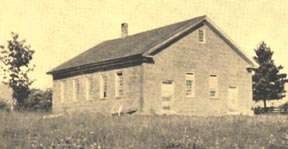 [This
Brick Church, as it was called, was built in 1832. Previously, the
Congregationalists of this area had been attending church in Tamworth,
which was about 40 miles away. Some would go on horseback and others
would walk. Rev. Samuel Hidden was the minister of the Tamworth church.
At the time of the organization of the North Sandwich Church the
following were some of it's members; Neal McCrillis, Isaiah Fogg, David
M. Foss, Joshua B. Smith, David S. Emery, Jonathan G. Webster, Albert L.
Emery, Joseph Hoit, Jacob F. Moulton, Stephen Bennett Jr., Isaac Foss,
Eliphalet McGaffey, William Weed, and Josiah McGaffey. Neal McGrillis
and Isaiah Fogg were deacons. On Dec. 19, 1832 it was voted to ask Rev.
Giles Leach to become the pastor of the church. The bricks that were
used in the construction on the new church came from the McCrillis kiln.
The church has long since been dismantled and the bricks have been sold
to various people and places. The Sandwich Historical Society in
Sandwich has been able to obtain many of the articles from the church
including the pulpit. A wonderful treat to view. Source: Sandwich
Historical Society]
[This
Brick Church, as it was called, was built in 1832. Previously, the
Congregationalists of this area had been attending church in Tamworth,
which was about 40 miles away. Some would go on horseback and others
would walk. Rev. Samuel Hidden was the minister of the Tamworth church.
At the time of the organization of the North Sandwich Church the
following were some of it's members; Neal McCrillis, Isaiah Fogg, David
M. Foss, Joshua B. Smith, David S. Emery, Jonathan G. Webster, Albert L.
Emery, Joseph Hoit, Jacob F. Moulton, Stephen Bennett Jr., Isaac Foss,
Eliphalet McGaffey, William Weed, and Josiah McGaffey. Neal McGrillis
and Isaiah Fogg were deacons. On Dec. 19, 1832 it was voted to ask Rev.
Giles Leach to become the pastor of the church. The bricks that were
used in the construction on the new church came from the McCrillis kiln.
The church has long since been dismantled and the bricks have been sold
to various people and places. The Sandwich Historical Society in
Sandwich has been able to obtain many of the articles from the church
including the pulpit. A wonderful treat to view. Source: Sandwich
Historical Society]
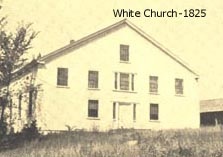 The White Church had
been built in 1825. Its congregation had always had a high level of
religious acitivity. In 1880, the Sabbath School had a membership of 150
and the North Sandwich Ladies Benevolent Association formed as early as
1853. In July 1887, the Reverend David Calley baptized fourteen new
converts in the Swift River at Weeds Mills. All seemed to be going so
well, and then disaster struck.
The White Church had
been built in 1825. Its congregation had always had a high level of
religious acitivity. In 1880, the Sabbath School had a membership of 150
and the North Sandwich Ladies Benevolent Association formed as early as
1853. In July 1887, the Reverend David Calley baptized fourteen new
converts in the Swift River at Weeds Mills. All seemed to be going so
well, and then disaster struck.
In June of 1897, the pastor of
the First Freewell Baptist Church, the Rev. H. B. Huntoon, was tried by
a "council of ministers on charges of immorality and indecency. He had
previously abruptly left town. On June 24, he was found guilty.
According to the Sandwich Reporter, this episode angered many bitter
feelings against the church.
This dissension was just the
beginning. In Jan. 1898, Rev. E.L. Krumreig was invited to the White
Church to hold evangelical services. At the end of his month's trial, it
seems that many parishioners disliked the man and by a vote of twelve to
six church leaders voted not to hire him. They accused the Reverend
Krumreig of not bringing truthful recommendations to the church.
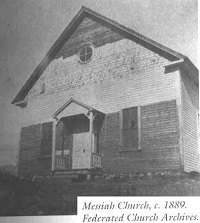 The rift within the church was such that in March 1898 steps were taken
by the Krumreig supporters, among whom were Daniel S. Watson, Walter S.
Tappan, Frank Tilton, Charles Ames, and John Atwood, to start a new
church. This church, to be called the Messiah Church, was built on land
donated by Daniel Tappan and R.S. Batchelder in Whiteface village. The
building was finished in Nov. 1899. Then to what must have been the
congregation's astonishment, the Reverend Krumreig abruptly resigned, to
take effect in March 1900, saying it was "within the Divine Plan."
The rift within the church was such that in March 1898 steps were taken
by the Krumreig supporters, among whom were Daniel S. Watson, Walter S.
Tappan, Frank Tilton, Charles Ames, and John Atwood, to start a new
church. This church, to be called the Messiah Church, was built on land
donated by Daniel Tappan and R.S. Batchelder in Whiteface village. The
building was finished in Nov. 1899. Then to what must have been the
congregation's astonishment, the Reverend Krumreig abruptly resigned, to
take effect in March 1900, saying it was "within the Divine Plan."
His replacement was Edwin Bundy, some of whose paintings hang in the
Sandwich Historical Society. The Rev. Bundy remained with the Messiah
Church for years, and the church served the neighborhood even after
regular services ceased.
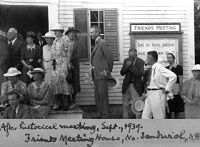 The most enduring congregation in North
Sandwich was that of the Quakers. To be a Friend, or Quaker, in Sandwich
or anywhere else always meant belonging to a wider community than a
single congregation or indeed a town. Quarterly meetings in Sandwich
were attended by Friends from towns as distant as Berwick, Maine or
Rochester or Dover, New Hampshire.
The most enduring congregation in North
Sandwich was that of the Quakers. To be a Friend, or Quaker, in Sandwich
or anywhere else always meant belonging to a wider community than a
single congregation or indeed a town. Quarterly meetings in Sandwich
were attended by Friends from towns as distant as Berwick, Maine or
Rochester or Dover, New Hampshire.
In a short history that John Hoag wrote, "Friends in Sandwich," he stated that by 1833 there were 700 members of the Society, more than a quarter of the population of the town. However, by 1884, only 67 Friends were left in town. In one year, 60 Hoags went west from Sandwich.
Rev.
J. D. Folsom’s letter to C. C. Fellows [regarding the beginning of
Methodism in Sandwich]
In 1805, perhaps before the close of this
Conference year, there were baptized in Sandwich by "Elder Dustin" the
following — Gilman Smith, Anna Smith, Fanny Glines and others....
1805. L. Bates and W. Bannister were on Tuftonboro’ Circuit. It is
quite probable that Bates traveled into some parts of Sandwich while he
was on this Circuit.
Not far from this time the first Class was
formed, consisting of Joseph Skinner, Elijah Skinner, a Mrs. Beede and
three others. Joseph Skinner was the first Class Leader. Miss Watson
says she has heard an old lady say, Lewis Bates was the first to
introduce Methodism into Sandwich, and that "Father Skinner" was the
first to open his house to Methodist preaching.
Mrs. Burnham says
the first Class Meeting was held at the house of Joseph Smith’s parents.
Bradbury Prescott is said to have been one of the first members.
I think we shall have to decide that Methodist meetings began in the Red
Hill District and in the more south eastern parts of the town at about
the same time, and the first meetings were held in Mrs. Beede’s house,
which stood near E. Hoag’s, where Glines now lives. E. Skinner lived
here afterward, and here also lived one Presiding Elder.
Extracted from History of the Methodist Episcopal Church of Sandwich, N.H., compiled by C. C. Fellows, 1884.
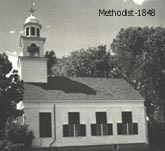 Individuals listed below are the original pew holders of the Methodist-
Episcopal Church of Centre Sandwich in December, 1848. The cost for this new
undertaking was met by the sale of the pews. Each pew had an appraised value
ranging from $20.00 to $38.00. In addition, there were four Free Slips, making a
total of 60 in all. The Free Slips were in the rear.
Individuals listed below are the original pew holders of the Methodist-
Episcopal Church of Centre Sandwich in December, 1848. The cost for this new
undertaking was met by the sale of the pews. Each pew had an appraised value
ranging from $20.00 to $38.00. In addition, there were four Free Slips, making a
total of 60 in all. The Free Slips were in the rear.
Wing Pews, left of Pulpit: Charles White, Isaiah Johnson, L. B. & Joseph Hanson, Thomas Weeks
Wing Pews, right of Pulpit: Asa Seavey, Darius Abbott, John Beede, John M. Smith
Wall Pews, left side
Elisha Marston
John C. Thompson
Samuel Thompson
William F. Dinsmore
Gilman Smith Jr.
Josiah Cook
Henry G. Chick
James M. Severance
Henry D. Howe
Wm. S. Prescott
Warren Dearborn
Greenlief Wallace
Left Aisle Pews
David M.Hodgon
M.H.Marston
M.H.Marston
Samuel Kimball
John Cook
Wm. Taylor
John Smith, 3rd
Simeon S. Felch
Charles G. Dow
Bldg. Committee
Bldg. Committee
Right Aisle Pews
Joseph G. Smith
Samuel Buswell
Daniel H. Folsom
Daniel Hoit
James M.Buswell
Timothy Varney
Michael W. Copp
Joseph Wentworth
Josiah Beede
Charles Taylor
Bldg. Committee
Bldg. Committee
Wall Pews, right side
Levi Smith
Thomas H. Beede
James M. Bean
Samuel Ethridge
George Page
Daniel G. Beede
Wm. Ladd
Lewis Smith
Thomas Smith
Isaac G. Mooney
Larkin D. Brown
Sally Clark
BEAN, James
Moses- Methodist- son of Orlando & Mehitable (Simpson) Bean, b. Aug. 27,
1827 and d. Apr 20, 1895 Lanark, Il; m. Grace, dau of Samuel & Lydia
(Cook) Etheridge, Dec. 8, 1847 in Sandwich,NH.
BEAN, Silas Frye-
Freewill Baptist- son of Andrew & Betsy (Sinclair) Bean, b. Oct. 3, 1807
d. Mar 6, 1890 in Melvin Village; m.(1) Ursula Abigail Seavey Oct. 10,
1836, (2) Mary Ann Abbott, Mar. 15, 1848
BEEDE,
Aaron- Congregational- son of Aaron & Mary (McGaffey) Beede, b. Jan 15,
1859 and d. Jan 27, 1879 in Sandwich; m. Rebecca Ridley, Dec 1, 1887
BEEDE, Hugh- Freewill Baptist- son of Elisha & Sally (Flanders)
Beede, b. Dec. 9, 1807 and d. Jan 27, 1879 Sandwich; m. Mary, dau of
Deacon Moses & Bethiah (Meacham) Worthen of Sandwich, Oct. 10, 1833.
COLBY, John- Freewill Baptist- son of Deacon Thomas & Elizabeth
(Atwood) Colby, b. Dec. 9, 1787 & d. Norfolk,VA.,Nov. 28, 1817.
CROSBY, Alpheus - Congregational- son of Dr. Asa & Abigail (Russell)
Crosby, b. Oct 13, 1810 & d. Apr. 17, 1874 Salem, MA, m. (1) Abigail
Grant Jones, Aug. 27, 1834 & (2) Martha Kingman, Feb. 12, 1861.
DORR, George Newell- Methodist- son of Sameul Hodgdon & Mary Melissa
Boyden (Wedgewood) Dorr, b. Jan 11, 1848 & d. Nov 25, 1931 Laconia, NH,
m. Mary Mehitable dau. of Darius & Mehitable (Prescott) [Bean] Abbott at
Sandwich, Dec. 15, 1875.
EASTMAN, David Clough - Methodist- son
of JAmes & Joannah (French) Eastman, b. Dec. 18, 1801 & d. Aug 24, 1869
Bloominburg, Ohio; m. (1) Sarah Moore, Mar. 6, 1828 (2) Margaret Jones,
Nov. 16, 1831 & (3) Ann, dau of Joseph Webster of Sandwich Aug. 31,
1833.
EASTMAN, Jacob Weed- Congregational- son of James & Joannah
(Susanna) (French) Eastman b. May 29, 1790 & d. July 2, 1852 Hanover,
IN, m. Mary dau of Wm & Anna (Cram) Webster of Sandwich Oct 3, 1811.
EASTMAN, John Calvin- Congregational- son of Rev. Jacob Weed & Mary
(Webster) Eastman, b. MAr. 17, 1813 & d. July 22, 1855 Hanover, IN; m.
(1) Nancy McMillen, Apr 10, 1834 & (2) Martha Dinwiddie Finley Aug 1,
1851.
ETHERIDGE, Albert - Methodist/Congregational - son of
Samuel & Lydia (Cook) Etheridge b. Jan 19, 1829 & d. ? Marseilles, IL;
m. (1) Marcia A. Forrest Dec. 2, 1852 & (2) Arzella Medoa Lovejoy June
16, 1875.
**FELLOWS, Albion-Methodist- son of Stephen & Rachel
(McGaffey) fellows b. Sept 26, 1827 & d. MAr 2, 1865 Evansville, IN; m.
Mary Erskine, July 20, 1854
**FELLOWS, Samuel McGaffey -
Methodist - son of Stephen and Rachel (McGaffey) Fellows b. Nov 23, 1818
& d. June 25, 1863 Mt. Vernon IA; m. Olive Parmelee Burr July 14, 1847.
**FELLOWS, Stephen Norris- Methodist- son of Stephen & Rachel
(McGaffey) Fellows b. May 30, 1830 & d.?? m. Sarah Leffingwell Matson
Mar. 13, 1856
**Note: According to research that was done by Cherryl
Ball , in Salt Lake City, using microfilm FHL15575, Whiteface Cemetery,
Intervale, North Sandwich Inscriptions, this information is not
completely correct.
Samuel was the son of Peggy/Margaret
McGaffey, Rachel's sister. Peggy/ Margaret was Stephen's first wife. She
died 9 June 1823 and is therefore the mother of Samuel. Stephen married
Rachel 7 Sept 1823 and is correctly the mother of Albion and Stephen.
Stephen and Peggy/Margaret had 10 children and he and Rachel had 5
children.
FOLSOM, Omar White- Congregational- son of Jesse &
Elizabeth (Varney) Folsom b. Apr 24, 1844 & d. ??; m. Isabella Clark Jan
27, 1873.
FRYE, Benjamin - Friends- b. about 1777 lived in
Sandwich nearly 50yrs. then Grinnell, IA
FURBER, Daniel Little -
Congregational- son of Jeremiah & Eliza Nichols (Little) Furber b. Oct
14, 1820 & d. Nov 19, 1899; m. Lucy Maria (Brigham) Peabody, Sept. 13,
1850
HARRIMAN, John - Methodist- b. Oct. 28, 1793 and d. Feb 18,
1873 Bangor, ME.
HINDS, Orlando - Methodist- son of Amherst
Hinds, b. Apr. 4, 1782 & d. Mar. 1, 1869 Chichester, NH; m. Mary
Brackett, Apr 5, 1808.
HOAG, Enoch - Friends- son of Stephen
Hoag, b. ~1820 & d. June 26, 1884 Sandwich; m.?
HOIT, William
Henry - Episcopal/Roman Catholic- son of Daniel and Sally (Flanders)
Hoit, b. June 8, 1813 and d. Dec 11, 1883; m. Anne Deming, Aug 21, 1838
KNOWLES, John D. - Freewill Baptist- son of Nathaniel Knowles, b.
1776 & d. July 11, 1840 Gilford, NH. m. Polly Danforth, Dec. 3, 1799
LEAVITT, Daniel Moulton - Advent- son of Caleb & Ruth (Moulton)
Leavitt, b. Apr 5, 1829 & d. ?; m. Charlotte Mary Shaw, Oct. 8, 1850
PAGE, John Cummings - Congregational- son of Moses & Sarah (Morse)
Page; b. May 4, 1804 d. Nov. 4, 1879 Center Harbor; m. Mary Ann Eastman,
June 26, 1828.
PETTENGILL, Dudley - Freewill Baptist- son of
Dudley &_____(Heath) Pettengill, b.1787 d. Apr. 29, 1850 Thornton Gore;
m. Hannah Boynton of Thornton Gore about 1837.
PETTENGILL, John -
Freewill Baptist- son of Samson Pettengill, b. Apr 7, 1806 & d. May 19,
1870; m. Sally dau of David & Susan (Colburn) Hatch at Sandwich, May 2,
1829.
PETTENGILL, John - Advent/Freewill Baptist- son of John &
Sally (Hatch) Pettengill b. Feb 7, 1834 & d.?; m. Laura Ann Reed, Jan.
1, 1855
QUINBY, Hosea - Freewill Baptist- son of Moses & Dolly
(Atkins) Quinby b. Aug 25, 1804 & d. Oct. 11, 1878 Action, ME; m.
Dorothea Burleigh of Sandwich, May 10, 1828.
SMITH, Benjamin
Burleigh - Freewill Baptist- son of John & Eliza (Webster) Smith b. Mar
17, 1820 & d. Nov. 22, 1872 Balazore, Orissa, India; m. Dorcas Folsom,
Jan 1, 1852.
TAPPAN, Charles Langdon - Congregational- son of
Jonathan & Dolly Beede (Heard) Tappan, b. June 26, 1828 & d. Feb 23,
1902 Concord, NH; m. Almira Remington Rice, May 18, 1876.
TAPPAN,
Edmund March - Freewill Baptist- son of Jonathan & Dolly Beede (Heard)
Tappan b. Sept 3, 1824 & d. Dec 12, 1860; m. Lucretia Logee, May 16,
1889
VITTUM, Edmund March - Congregational- son of Stephen & Ruth
Ann (Tappan) Vittum, b. Oct. 24, 1855 and d. Jan 19, 1938; m. Annie
Griswold, May 16, 1889.
WEBBER, Charles H. - Freewill Baptist-
son of rev Horace & Relief (Tyler) Webber, b. 1831 and d. July 30, 1899
in Saco, ME.
1656 - In this year, began, what is generally and properly termed, the
persecution of the Quakers. A fine of ten pounds was inflicted on any
person, who harbored a Quaker. In October of this year, eleven of the
sect, received sentence of banishment; and the master of the ship, which
brought them from England, was required to bind himself with sureties to
the amount of 500 l. to carry them all out of the country. (See Hutch.
Vol. .I p.97)
Mr. Hutchinson observes, that "he could not find
what law they had for this." In this month also, an act passed imposing
a fine of 100 l. upon any master of a vessel, who should bring a Quaker
into the colony, and that if a Quaker should arrive, he should be
immediately sent to the house of correction, receive twenty stripes, and
be confined to hard labor until he could be transported.
At the
next session, an act passed, by which all persons were liable to a fine
of forty shillings for harboring a Quaker one hour. After the first
conviction under this act, the offender, if a man, was to lose one ear,
and upon the third conviction, the other; if a woman, she was for each
offense to be whipped, and upon the fourth conviction, the offender,
whether man or woman was to have the tongue bored through with a hot
iron.
In May, 1658, a penalty was inflicted upon every person,
who should attend a Quaker meeting. Under this act, a child only eleven
years old, by the name of Patience Scott, was tried and imprisoned. The
imprisonment of such a child was as strange as any further severity
would have been horrible.
1660 - Two Quakers, by the names of
William Robertson and Marmaduke Stevenson, were executed on the 27th of
October. Several persons were fined to the amount of 10 l. for
entertaining Quakers at their houses, and one man, of the name of
Wharton, for piloting them from one port to another, was ordered to
receive twenty stripes.
Several others were executed, banished or
whipped. Bishop says, "they cut off the ears of Holden, Capeland, and
Rouse in prison, and that others were whipped and banished upon pain of
death." In this inquisitorial persecution, the clergy were the most
active.*
The sufferings of the victims excited the compassion of
the people, many of whom resorted to the prisons by day and night, so
that the keepers were forced to establish a constant guard to restrain
them. Wendlock Christopherson among others was sentenced to die. This
man implored the court to consider, whether they gained anything by the
persecution.
For the last man, said he, that was put to death,
five rose up in his stead; and although you have power to take my life,
God can inspire the same principles into ten more of his servants and
send them among you, that you may have torment upon torment. This man
was executed June 13th, 1660. Some of his persecuted companions were
tried at Hampton. May those unhappy days never return, when men suppose
they are doing God service by sporting with the lives of his children.
*The pillory served George Fox for his pulpit. From this he
harangued the populace. Inflamed by his eloquence, they raised a mob and
released him, and set in the same pillory a certain clergyman, who had
been instrumental in imprisonment of Fox.
Source: The Gazetteer of the State of New Hampshire by Eliphalet Merrill & Phinehas Merrill, Esq.
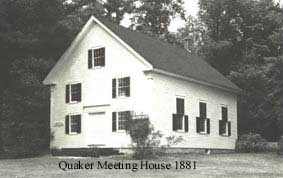
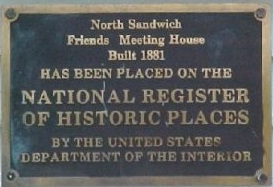
In 1792, the town of Wolfeboro hired a
town minister, Rev. Ebenezer Alien. His salary was paid by a minister's
tax that was levied on all taxpayers. The town-meeting house, at
Wolfeboro Center, was equipped with pews, paid for by pew-holders, most
of whom were Congregationalists.
There were some Baptists and
Quakers in the town and they objected to paying the minister's tax. They
petitioned the town to separate the business of the town from that of
the parish. The town rejected the petition. Thomas Cotton then
petitioned the town meeting to release him from paying the minister's
tax. The town refused, and so in that fall of 1802, the tax assessor
assessed Thomas Cotton $1.92 for the minister's tax.
Cotton
refused to pay so the assessor took one of Cotton's cows in January
1803. He then sold it at public auction. Expectedly, Cotton sued the
town but the county court in Dover delayed it until 1806. The town
finally settled out of court, paying Cotton $20.00 for the cow.
Altogether, it cost the town $75.00, and the taxation for ministerial
support ended in Wolfeboro.
Copyright © 1996 - The USGenWeb® Project, NHGenWeb, Carroll County